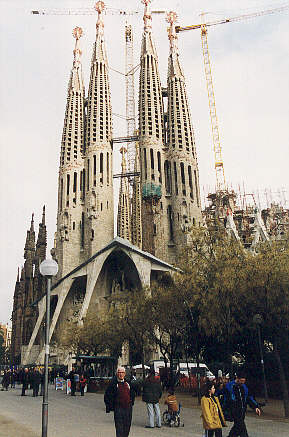
Barcelona and Toulouse
On Ash Wednesday we flew Air France/Delta from the Cincinatti airport to Paris (Charles de Gaulle), then made a connection there to Barcelona. From my journal:
Noon Thursday: Lissa and I sit in a restaurant (Pomme de Pain) at Terminal F. We are dead tired from the flight. Our connection to Barcelona leaves in another hour.
The flight from Cinci was long and uneventful. We didn't sleep much, and we certainly did not do any reading for our Toulouse class. We saw a bad Susan Serandon movie, and tried to rest during "The Pelican Brief". Hopefully we can nap on the next plane.
We were totally confused by the construction at CDG. What a mess.
We arrived safely at the airport, took the A1 bus to the Placa de Catalunya, and checked in at the Hotel Meson Castilla. We both showered and crashed...after our naps we began to feel human again...
We ventured out after 8PM, ate at the Barcelona equivalent of a Subway (at that point we were too tired to be imaginative or adventurous) then walked down the Ramblas all the way to the statue of Christopher Columbus. By the time we got to the cybercafe it was closed, so we will try again tomorrow. After a more walking around, we returned to the hotel around midnight.
We spent four days exploring Barcelona. Taking the red Bus Turistic gave us a good overview of the city, including Sagrada Familia.

The Sagrada Familia
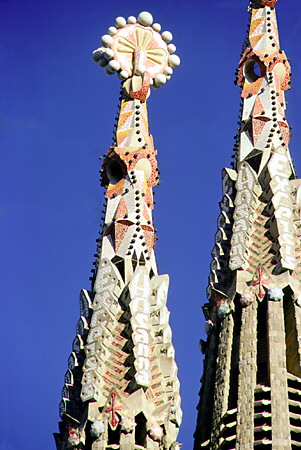
The Hosanna and Excelsis towers
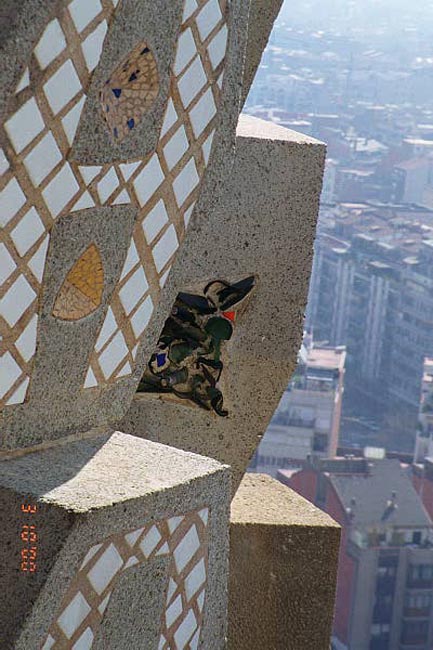
Detail of spire, Sagrada Familia

Protester hanging between spires of Sagrada Familia. He was hanging a banner to announce a peaceful rally in support of Third World debt relief. At first, Liss and I thought he was a worker or something. By the time we returned to the ground, the police were directing the crowds away from this section of the towers.
Click here for a link to a site that describes this work in progress
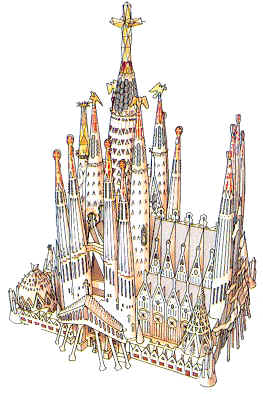
Sketch of plans
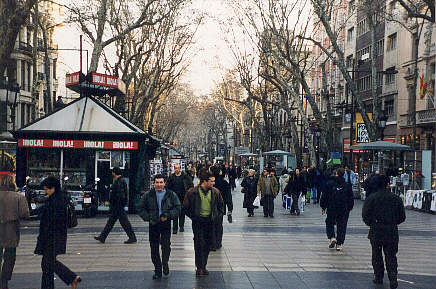
Walking on Las Rambla
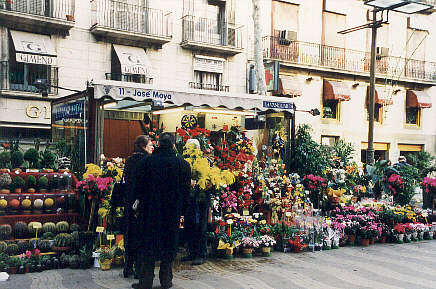
La Rambla
We took the Julia
tour to Montserrat: simply amazing!
My foot is really blistered by now, but I'll live.
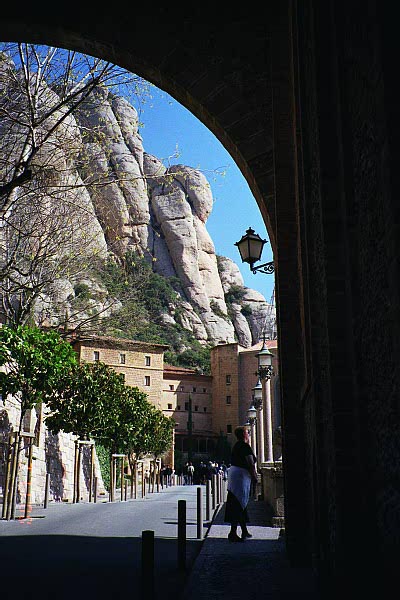
A view of Montserrat (and Lissa)
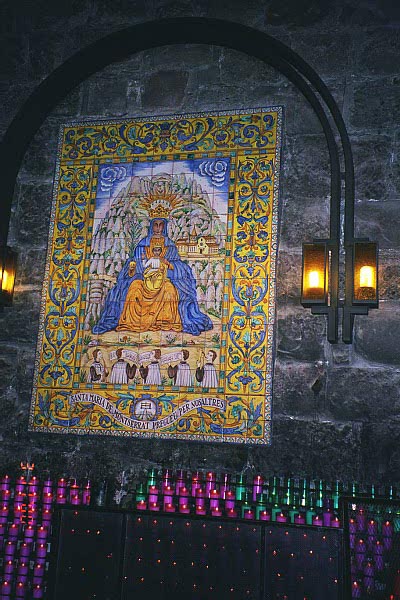
Mosaic, Santa Maria de Montserrat

St. Eulalia
Cathedral, main cathedral in Barcelona.
This is where we watched the locals dance the Sardana.
We then travelled by train to Toulouse on Sunday evening. The route required that we change trains in Narbonne, France. At that point Lissa and I had been traveling for a while, and she needed to find a restroom. We did--it was one building over from the train station terminal. We lugged our stuff over, then up a few steps to the public restroom. I was waiting outside the door for Liss with our luggage when I heard her voice from inside:
"Veronica, I don't see the toilet in here...I can't find it!"
I asked if she was sure...and she was, so I told her I was coming in. I suspected that she was about to encounter her first Turkish toilet. Haven't seen one? Click here. They are basically flat ceramic fixtures, recessed into the floor. They usually have two foot-sized areas to stand or squat on. It's probably not a big deal for men, but women are usually intimidated by the thought of losing their balance in the process.
Once I came inside, I looked at the floor, saw the toilet, and pointed down to it for Lissa. At that point we burst out laughing! I don't either of us expected this type of thing in France. Thankfully I had plenty of extra tissue and hand sanitizer in my purse.
We arrived safely in Toulouse for five days at the Groupe Ecole Supérieure de Commerce--a business school with exchange programs to many international universities. The University of Dayton's MBA program offers this experience as part of MBA 656. We learn about working with Europeans in the context of business culture, and come to understand that knowing another's language is not the same as knowing their culture.
The Toulouse segment course consists of a field trip to Aerospatiale, reading, class lectures, and discussion.
After class each day we venture out to explore Toulouse...

Pont Neuf Bridge, Toulouse

Bell Tower,
St-Sernin
St-Sernin basilica was the headquarters of St-Dominique's
Cathar-hunting Inquisition

From the Crypt tour, St-Sernin
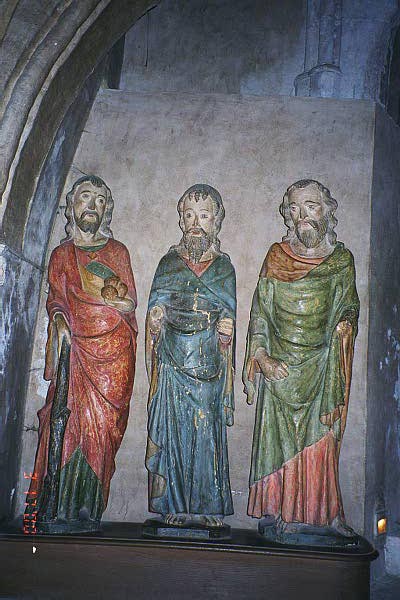
More from the Crypt tour, St-Sernin
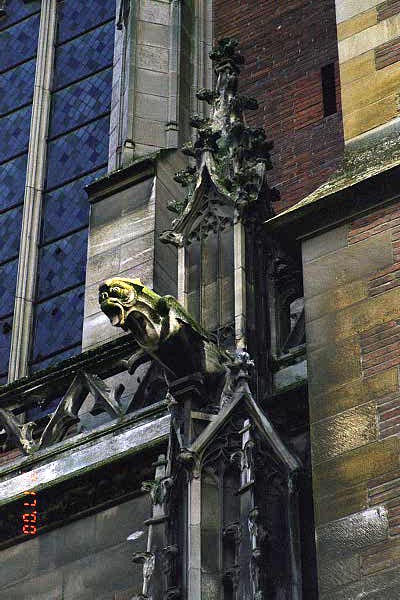
Gargoyle, St-Ettienne, Toulouse

Capitol, Toulouse
We also visited Les Jacobins, which houses St. Thomas Aquinas' ashes and Notre Dame de Taur.
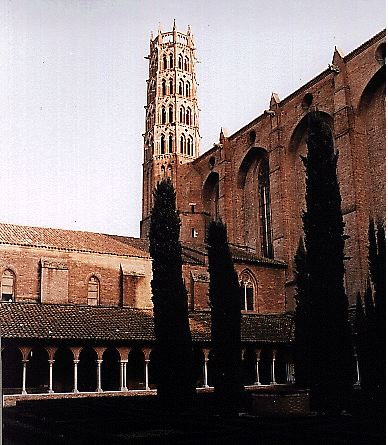
Les Jacobins

Altar and reliquary
at Les Jacobin
The relics of St. Thomas Aquinas
Finding St. Thomas
Aquinas was quite an adventure. We read in a tourbook that
his remains were located in one of the local churches, but had
forgotten the name and location of the church. We asked
several locals in our very bad French something like "Ou et
'Saint Thomas Aquinas'?" ...and no one seemed to understand,
even when we made gestures for 'dead' and 'saint'.
Finally we located a tourism bureau, where there were several
English-speaking guides. We repeated our question
about the saint's remains, pronouncing his name something like
"toe-MAS uh-KWINE-us". All we received were
blank stares, until one nice guide listened closely and said
"AH!"...then pronounced for us the name again:
"sahn toe-MAH-duh-KEEN" (!) She chalked our
problems up to our American accents, and sent us off to find St.
Thomas Aquinas...at the Musée des Augustins...the wrong place!
We finally found someone at the museum who knew that the remains
were located in Les Jacobins...so we left the Musée, found Les
Jacobins, and there he was, underneath the altar. Here is a
quote from the Catholic Information Network about the relics:
"The University of Paris sent to the general and provincial of the Dominicans a letter of condolence upon his death, giving the highest commendations to the saint's learning and sanctity, and begging the treasure of his holy body. Naples, Rome, and many other universities, princes, and orders contended no less for it. One of his hands, uncorrupt, was cut off in. 1288, and given to his sister, the Countess Theodora, who kept it in her domestic chapel of San Severino. After her death it was given to the Dominicans' convent of Salerno. After several contestations, Pope Urban V, many years after his death, granted his body to the Dominicans to carry to Paris or Toulouse, as Italy already possessed the body of St. Dominic at Bologna. The sacred treasure was carried privately into France, and received at Toulouse in the most honorable manner: one hundred and fifty thousand people came to meet and conduct it into the city, having at their head Louis, Duke of Anjou, brother to King Charles V, the archbishops of Toulouse and Narbonne, and many bishops, abbots, and noblemen. It rests now in the Dominicans' church at Toulouse, in a rich shrine, with a stately mausoleum over it, which reaches almost up to the roof of the church, and hath four faces. An arm of the saint was at the same time sent to the great convent of the Dominicans at Paris, and placed in St. Thomas's chapel in their church, which the king declared a royal chapel. The faculty of theology meets to assist at a high mass there on the anniversary festival of the saint. The kingdom of Naples, after many pressing solicitations, obtained, in 1372, from the general chapter held at Toulouse, a bone of the other arm of St. Thomas. It was kept in the church of the Dominicans at Naples till 1603, when the city being delivered from a public calamity by his intercession, it was placed in the metropolitan church among the relics of the other patrons of the country."
Be glad that you aren't a saint: would you want a bunch of monks to dismember your body and have pieces sent to various chapels after you died? Or to be disinterred and moved around after others "contended" for it? Yuck.